The Adventures of Sherlock Holmes
BY A.
CONAN DOYLE
XXIV. - THE ADVENTURE OF THE FINAL PROBLEM
The Adventures of Sherlock Holmes
BY A.
CONAN DOYLE
XXIV. - THE ADVENTURE OF THE FINAL PROBLEM
Greetings,
It was with a heavy heart that Sidney Paget took up his pen to illustrate the last adventure of Sherlock Holmes. He signed his full name to three of the drawings and dated two of these, underscoring the finality of the events.
As always Paget takes his cues from the writings; as always, he adds his own interpretations to the story in the images he creates.
One strand that Doyle/Watson continues from
NAVA is the melancholy
romanticism of Holmes. In NAVA it is expressed through musings about
a rose and the "cheering" view of the life of the masses of English.
In FINA it is continued as the story moves out of London, the center
of Moriarty's web, to the natural innocence of the Continent where Holmes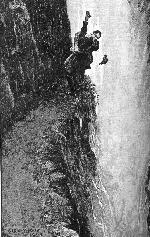 and Watson spend a "charming week" engaged in a "lovely trip." A
trip that Watson notes brings out the best in Holmes who confides that
he would "cheerfully bring his own career to a conclusion" if he could
free society - that which he had recently ennobled in his NAVA reverie
- from Moriarty.
and Watson spend a "charming week" engaged in a "lovely trip." A
trip that Watson notes brings out the best in Holmes who confides that
he would "cheerfully bring his own career to a conclusion" if he could
free society - that which he had recently ennobled in his NAVA reverie
- from Moriarty.
Yet, Paget chooses to avoid the stereotypical
pictures of a romantic communing with nature and instead uses the natural
settings to underscore the corruption of it by Moriarty's presence. The
frontispiece (signed and dated) shows the falls as "the fearful place"
Watson calls it as Holmes and Moriarty wrestle on the narrow path.
Another illustrations of corrupted nature show the rock clattering down the hill behind Holmes and Watson, while the last view of the falls shows Watson reaching to grab the note which Holmes penned in what he knew was a farewell
The most
dramatic romantic nature picture appears to the unsuspecting Watson to
show Holmes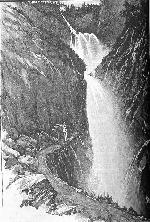 reflecting
on the falls much as he did the Rose in NAVA - entranced by the mystery
and majesty of nature. Yet Paget has created a false veneer in this
scene to hide the corruption of this scene by the presence of Moriarty,
upon whose arrival and upon whose actions Holmes awaits resignedly.
reflecting
on the falls much as he did the Rose in NAVA - entranced by the mystery
and majesty of nature. Yet Paget has created a false veneer in this
scene to hide the corruption of this scene by the presence of Moriarty,
upon whose arrival and upon whose actions Holmes awaits resignedly.
This sense of resignation is another theme that Paget has captured.
Holmes has uncharacteristically allowed the initiative to be seized by
Moriarty. A villain whose skill caused Holmes to be "lost in admiration
of his crimes." A villain who has so convinced Holmes that he is a match
for him that he relies on the police to investigate the attempts on his
life and flees to the Continent rather than be in on the capture, and even
muses to Watson that "it would have been a coup-de-matre had he deduced
what I would deduce and acted accordingly." This resignation of fate
is represented in the Paget drawings. In the first Holmes sits
cross legged avoiding his friend's gaze as he relates the tale of Moriarty.
Bark knuckles clinched and cigarette dangling 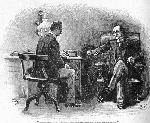 above
the clawed feet of the demi-throne on which Paget has sat him.
Watson, in contrast, sits stiff legged on the edge of his chair and is
well lit by the lamp which casts dark shadows upon the clearly exhausted
Holmes.
above
the clawed feet of the demi-throne on which Paget has sat him.
Watson, in contrast, sits stiff legged on the edge of his chair and is
well lit by the lamp which casts dark shadows upon the clearly exhausted
Holmes.
The resolve in Holmes eyes as he stares Moriarty out of the room
at the end of their Baker Street interview is belied by the hand set close
to the revolver on the table. Moriarty - drawn cadaverously evil
by Paget - glances back and turns his foot - as if he senses the weakness
of the moment 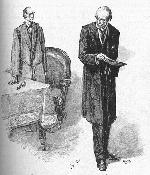 and
considers making a desperate move here in the lair of the detective.
Instead he settles for attempting to burn the lair to force the detective
out into his element.
and
considers making a desperate move here in the lair of the detective.
Instead he settles for attempting to burn the lair to force the detective
out into his element.
Clearly Holmes has decided that he must sacrifice himself to preserve
English society from being corrupted by Moriarty. It is a sacrifice
which he embraces, and the serenity of this choice is brilliantly captured
in the closing piece showing Holmes casually attired in a smoking gown
and perhaps reflecting on the goodness of the deeds he has done. 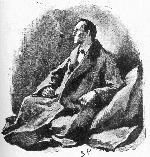 It is in sharp contrast to the frontispiece which depicts the frantic struggle
of good and evil as the cap of Holmes flutters to the falls.
Paget has thematically book ended the story in a manner that complements
and extends the textual meanings of good v evil, chaos v evil, and, of
course, beginnings and endings that blur in life and fiction.
It is in sharp contrast to the frontispiece which depicts the frantic struggle
of good and evil as the cap of Holmes flutters to the falls.
Paget has thematically book ended the story in a manner that complements
and extends the textual meanings of good v evil, chaos v evil, and, of
course, beginnings and endings that blur in life and fiction.
Holmes was the best and wisest man that Watson and Paget or any of us has ever known, and the final tribute shows this well.
Take Care